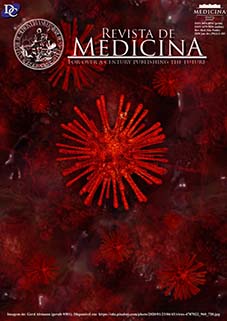Uso pré-hospitalar do ácido tranexâmico
uma revisão de literatura
DOI:
https://doi.org/10.11606/issn.1679-9836.v99i1p62-65Palavras-chave:
Ácido tranexâmico, Ferimentos e Lesões, Hemorragia, Assistência pré-hospitalarResumo
Introdução: Estudos demonstram a eficácia do uso do ácido tranexâmico (AT) em ambiente hospitalar no manejo de hemorragias decorrentes do trauma, porém, a eficácia no seu uso em meio pré-hospitalar ainda é discutida. Objetivos: Avaliar os estudos referentes ao uso do AT no meio pré-hospitalar. Métodos: A estratégia de busca baseou-se na pesquisa de artigos nas bases de dados PubMed/MedLine e SciELO e usou como descritores os termos “tranexamic AND prehospital AND trauma”, em todos os idiomas, o que resultou em 37 artigos após análise final. Resultados: Os estudos analisados mostraram redução da taxa de mortalidade quando o AT é administrado em até 3 horas após o trauma. O uso militar do AT já é realizado por alguns países com estudos que confirmam seus benefícios. Não foram encontrados estudos nacionais sobre o assunto e também não foram encontrados artigos em que a classe pediátrica fosse incluída. Conclusão: Os resultados das pesquisas analisadas corroboram com a eficácia do uso pré-hospitalar do AT, porém alguns pontos ainda precisam ser analisados em pesquisas futuras como a eficácia e segurança do uso pré-hospitalar de AT em crianças e também seu uso em território nacional, já que não foram encontrados artigos que abordem esses temas. Resultados de estudos em andamento podem esclarecer melhor o seu uso.
Downloads
Referências
2. Centers for Disease Control and Prevention (CDC). CDC 24/7: Saving Lives, Protecting PeopleTM. Wisqars (Web-based Injury Statistics Query and Reporting System) Injury Center CDC. Washington (DC): US Department of Health & Human Services; 2019 [cited 30 July 2019]. Available from: https://www.cdc.gov/injury/wisqars/index.html.
3. Kauvar D, Lefering R, Wade C. Impact of hemorrhage on trauma outcome: an overview of epidemiology, clinical presentations, and therapeutic considerations. J Trauma Injury Infect Crit Care. 2006;60(Suppl):S3-S11. doi: http://dx.doi.org/10.1097/01.ta.0000199961.02677.19.
4. Wu G, Mazzitelli B, Quek A, Veldman M, Conroy P, Caradoc-Davies T, et al. Tranexamic acid is an active site inhibitor of urokinase plasminogen activator. Blood Adv. 2019;3(5):729-33. doi: http://dx.doi.org/10.1182/bloodadvances.2018025429.
5. Shakur H, Roberts I, Bautista R, Caballero J, Coats T, Dewan Y, et al. Effects of tranexamic acid on death, vascular occlusive events, and blood transfusion in trauma patients with significant haemorrhage (CRASH-2): a randomised, placebo-controlled trial. Lancet. 2010;376(9734):23-32. doi: http://dx.doi.org/10.1016/s0140-6736(10)60835-5.
6. The CRASH-3 trial collaborators. Effects of tranexamic acid on death, disability, vascular occlusive events and other morbidities in patients with acute traumatic brain injury (CRASH-3): a randomised, placebo-controlled trial. Lancet. 2019;394(10210):1713-23. doi: https://doi.org/10.1016/ S0140-6736(19)32233-0.
7. Wafaisade A, Lefering R, Bouillon B, Böhmer A, Gäßler M, Ruppert M. Prehospital administration of tranexamic acid in trauma patients. Crit Care. 2016;20(1):143. doi: http://dx.doi.org/10.1186/s13054-016-1322-5.
8. El-Menyar A, Sathian B, Wahlen B, Abdelrahman H, Peralta R, Al-Thani H, et al. Prehospital administration of tranexamic acid in trauma patients: a 1:1 matched comparative study from a level 1 trauma center. Am J Emerg Med. 2019 Apr 30. pii: S0735-6757(19)30293-1. doi: 10.1016/j.ajem.2019.04.051.
9. Morrison J. Military Application of Tranexamic acid in Trauma Emergency Resuscitation (MATTERs) Study. Arch Surg. 2012;147(2):113. doi: http://dx.doi.org/10.1001/archsurg.2011.287.
10. Morrison J, Ross J, Dubose J, Jansen J, Midwinter M, Rasmussen T. Association of cryoprecipitate and tranexamic acid with improved survival following wartime injury. JAMA Surg. 2013;148(3):218. doi: http://dx.doi.org/10.1001/jamasurg.2013.764.
11. Mrochuk M, ÓDochartaigh D, Chang E. Rural trauma patients cannot wait: tranexamic acid administration by Helicopter Emergency Medical Services. Air Med J. 2015;34(1):37-9. doi: http://dx.doi.org/10.1016/j.amj.2014.09.
12. Wearmouth C, Smith J. Development of a nurse-led tranexamic acid administration protocol for trauma patients in rural South Africa. Afr J Emerg Med. 2019;9:S52-S55. doi: http://dx.doi.org/10.1016/j.afjem.2018.10.001.
13. Brown J, Neal M, Guyette F, Peitzman A, Billiar T, Zuckerbraun B, et al. Design of the Study of Tranexamic Acid during Air Medical Prehospital Transport (STAAMP) Trial: addressing the knowledge gaps. Prehospital Emerg Care. 2014;19(1):79-86. doi: http://dx.doi.org/10.3109/10903127.2014.936635.
14. Gruen R, Jacobs I, Reade M. Trauma and tranexamic acid. Med J Austr. 2013;199(5):310-11. doi: http://dx.doi.org/10.5694/mja13.10747.
15. Reade M, Pitt V, Gruen R. Tranexamic acid and trauma. Shock. 2013;40(2):160-1. doi: http://dx.doi.org/10.1097/shk.0b013e31829ab240.
16. Faraoni D, Goobie S. The efficacy of antifibrinolytic drugs in children undergoing noncardiac surgery. Anesthes Analg. 2014;118(3):628-36. doi: http://dx.doi.org/10.1213/ane.0000000000000080.
17. Pinto M, Silva J, Chedid A, Chedid M. Use of tranexamic acid in trauma patients: an analysis of cost-effectiveness for use in Brazil. ABCD Arq Bras Cir Dig (São Paulo). 2016;29(4):282-6. doi: http://dx.doi.org/10.1590/0102-6720201600040017.




